
Welcome to Hyperion Records, a British classical label devoted to presenting high-quality recordings of music of all styles and from all periods from the twelfth century to the twenty-first.
Hyperion offers both CDs, and downloads in a number of formats. The site is also available in several languages.
Please use the dropdown buttons to set your preferred options, or use the checkbox to accept the defaults.


Compositionally, the two-piano version came first (completed 10 August 1940), the orchestration second (New York, 22 September–29 October)—which may help to explain, perhaps, why some ideas seem to function better pianistically than they do orchestrally.
Festive, grotesque, plaintive, uneasy, macabre, conquering—‘arguably the greatest work for the [two-piano] medium written in the twentieth century’ (Robert Matthew-Walker). The opening dance (C minor) is march-like, nostalgically looking back forty-five years to the First Symphony, with a central C sharp minor modal section of ‘simple tragedy’. The second movement (G minor) is a languorous waltz, concerned, Olin Downes imagined, with ‘sensuous melodies, sometimes bittersweet, sometimes to a Viennese lilt—and Vienna is gone’ (New York Times, 8 January 1941). ‘A lugubrious ennui shuffles through it, and Ravel, Richard Strauss and Sibelius join the dance in deep purple. The memories crowd in thick and fast’, thought another critic, Louis Biancolli (New York World-Telegram, same date). Malignant apparitions (the Dies irae plainchant: Death) finally overcome (the old Russian orthodox hymn, ‘Blessed be the Lord’: God’s victory) underline the third movement, a complex web of gigue rhythms, famously cross-accented (D major/D minor).
Rachmaninov’s record company was less enlightened than Medtner’s. When he proposed to record the Symphonic Dances and Second Suite with Horowitz, RCA rejected the project. Extraordinary.
from notes by Ateş Orga © 1993
La version pour deux pianos fut composée en premier (achevée le 10 août 1940), et fut suivie de l’orchestration (écrite à New York entre le 22 septembre et le 29 octobre)—ce qui explique peut-être pourquoi certaines idées semblent mieux fonctionner sous leur forme pianistique que dans leur contexte orchestral.
Une musique festive, grotesque, plaintive, anxieuse, macabre, conquérante—«sans doute la plus grande œuvre [pour deux pianos] écrite au XXe siècle» (Robert Matthew-Walker). La danse initiale (ut majeur), semblable à une marche, évoque avec nostalgie la Première symphonie, composée quarante-cinq ans plus tôt, avec une section centrale au caractère de «simple tragédie». La seconde (sol mineur) est une valse langoureuse—avec ses mélodies qu’Olin Downes décrivit comme «voluptueuses, tantôt aigres-douces, tantôt aux accents viennois—et Vienne disparaît aussitôt» (New York Times, 8 janvier 1941). «Il s’y traîne un ennui lugubre, et Ravel, Richard Strauss et Sibelius se joignent à la danse avec bravoure. Les souvenirs pleuvent», pensa un autre critique, Louis Biancolli (New York World-Telegram, même date). La troisième danse—un tissu compliqué de rythmes de gigue (ré majeur/ré mineur)—est quant à elle sous-tendue par la victoire de Dieu (exprimée par l’ancien hymne orthodoxe russe «Béni soit le Seigneur») sur la mort (symbolisée par les apparitions pernicieuses du plain-chant Dies Irae).
La maison de disques de Rachmaninov était moins éclairée que celle de Medtner. Lorsqu’il proposa d’enregistrer les Danses symphoniques et la Deuxième Suite avec Horowitz, RCA rejeta le projet. Extraordinaire.
extrait des notes rédigées par Ateş Orga © 1993
Français: Jean-Paul Metzger
Die Version für zwei Klaviere (am 10. August 1940 fertiggestellt) ging der orchestrierten Version voraus (22.9–29.10, 1940 in New York), was erklären mag, weshalb manche Ideen pianistisch wirksamer sind als orchestrisch.
Festlich, grotesk, klagend, beklommen, makaber, siegreich. „Wohl das größte Werk für dieses Ausdrucksmittel [zwei Klaviere], das in im 20. Jahrhundert komponiert wurde“ (Robert Matthew-Walker). Der einleitende marschähnliche Tanz in C-Dur mit dem Mittelteil einer „schlichten Tragödie“ blickt nostalgisch 45 Jahre zurück, auf die 1. Symphonie. Der zweite Tanz in g-Moll ist ein schmelzender Walzer. Dazu Olin Downes (New York Times, 8. Januar 1941): „Es geht um sinnliche Melodien, manchmal bittersüß, manchmal im Rhythmus eines Wiener Walzers. Doch Wien ist nicht mehr.“ Ein anderer Kritiker (Louis Biancolli, New York World-Telegram, auch 8. Januar 1941) drückte sich folgendermaßen aus: „Ein schwermütiger Ennui schlurft durch die Komposition, und Ravel, Richard Strauss und Sibelius nehmen in tiefem Violett am Tanz teil. Die Erinnerungen prasseln herein.“ Bösartige Erscheinungen (der Cantus planus Dies Irae: Tod), die schließlich überwältigt werden (die alte russisch-orthodoxe Hymne „Gesegnet sei der Herr“: Gottes Sieg), unterstreichen den dritten Tanz, ein kompliziertes Gewebe von Gigue-Rhythmen (D-Dur/d-Moll).
Rachmaninoffs Grammophongesellschaft war weniger aufgeschlossen als die Medtners. Als ersterer vorschlug, die Symphonischen Tänze und 2. Suite mit Horowitz aufzunehmen, lehnte die RCA ab. Erstaunlich.
aus dem Begleittext von Ateş Orga © 1993
Deutsch: Eike Hibbett
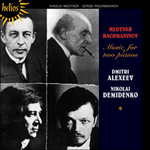 Medtner: Music for two pianos Medtner: Music for two pianos‘Phenomenal … transcendental’ (BBC Music Magazine Top 1000 CDs Guide) ‘I would happily recommend all Russophiles buy this disc for the stunning Medtner performances alone’ (CDReview)» More |
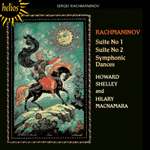 Rachmaninov: Music for two pianos Rachmaninov: Music for two pianos‘A worthy continuation of Hyperion's Rachmaninov series’ (BBC Music Magazine) ‘First-rate playing, splendid sound, value for the money’ (American Record Guide)» More |
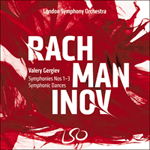 Rachmaninov: Symphonies Nos 1-3 & Symphonic Dances Rachmaninov: Symphonies Nos 1-3 & Symphonic DancesA new collection bringing together Valery Gergiev’s acclaimed cycle of the complete Rachmaninov symphonies with the London Symphony Orchestra. Also included are the Symphonic Dances and two symphonic poems by Mili Balakirev.» More |
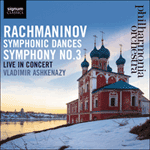 Rachmaninov: Symphony No 3 & Symphonic Dances Rachmaninov: Symphony No 3 & Symphonic DancesThe concluding release in this mini series presents Rachmaninov's Symphony No 3, the work of an exile in America with poignant allusions to the world of a lost Russia, alongside the perennially popular Symphonic Dances, the composer's final work, ...» More |
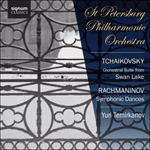 Tchaikovsky: Swan Lake; Rachmaninov: Symphonic Dances Tchaikovsky: Swan Lake; Rachmaninov: Symphonic DancesThe St Petersburg Philharmonic Orchestra presents one of Tchaikovsky’s most famous ballets Swan Lake, complemented with Rachmaniov’s final composition Symphonic Dances.» More |

